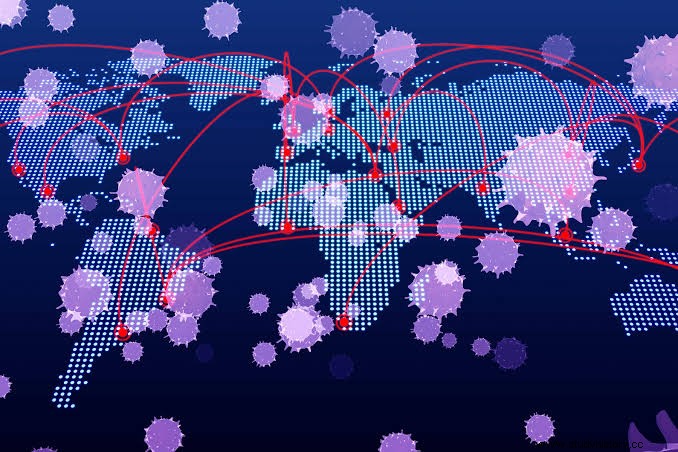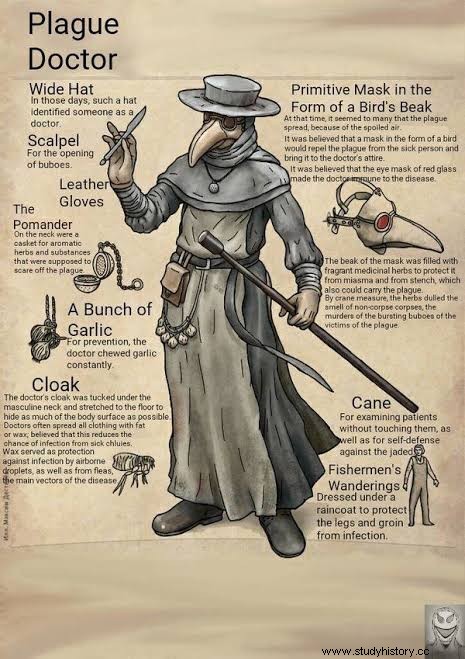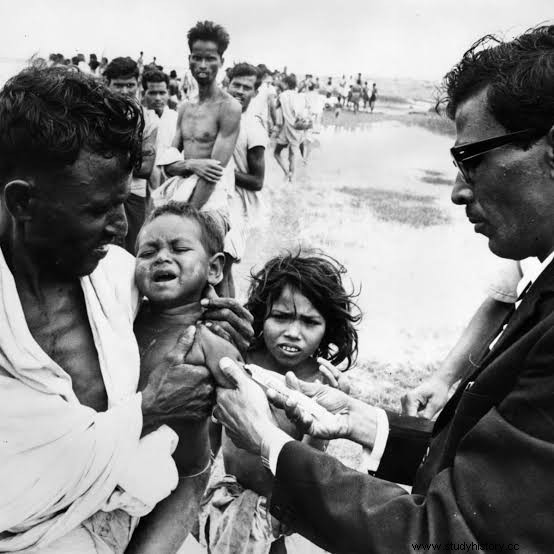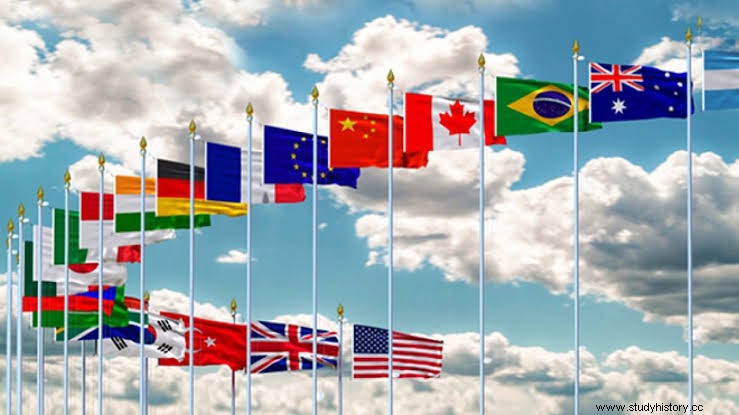Introduction
There is a theory that a pandemic happens every hundred years. At first glance, nothing seems scary with the statement, but the accuracy with which these events take place is scary. This theory has proven to be false because there were many other pandemics that took place between these years. The World Health Organization explains a pandemic as "the worldwide spread of a new disease". The definition of the United States Center for Disease Control and Prevention is almost the same, "A pandemic is a global outbreak of disease. Pandemics occur when a new virus emerges to infect humans and can spread between humans in a sustainable way." / P>
1347- The Black Death Pandemic
The Black Death (also known as the plague, the great mortality or plague) was a bubonic plague (a rare but serious infection transmitted by fleas) that occurred in Afro-Eurasia from 1346 to 1353. It is the most fatal pandemic recorded in human history. and caused 75-200 million people to die in less than 4 years, in Eurasia and North Africa, which peaked in Europe from 1347 to 1351. Yersinia pestis is the bacteria that caused the plague. Fleas were the main carriers, causing spread. These insects pick up the bacteria when they bite in infected animals such as rats, squirrels or mice and pass it on to the next thing they bite.
Not only was the Black Death the deadliest, it was also the longest pandemic of all time. This alone disease spread more than a mile per day. Today we think another mile is a short distance, but back then it was definitely not right around the corner, nor did they have the right medication to treat this disease. While today there are antibiotics for it, and the disease is not as deadly.
The name of the name
Black death, got its name from a symptom:lymph nodes that turned black and swollen after bacteria entered through the skin.
-

- Source:Robert Valette / Wikimedia
A ship named Grand Saint-Antoine arrived at a port from Marseille, France, loaded with cotton, fine silk and other goods. The invisible load also carried the bacteria known as Yersinia pestis, which launched the great plague in Provence, the last major outbreak of bubonic plague in Europe. The disease killed a total of one hundred thousand people:50,000 50,000 in the city over the next two years and a further XNUMX XNUMX north in the surrounding provinces and cities.
This plague was one of the four worst pandemics in history, with the Black Death in second place. Although economic activity took only a few years to recover, as trade expanded to the West Indies and Latin America, it was not until 1765 that the population returned to the level before 1720.
1817-Cholera outbreak and pandemics (the blue death)
-

- Credit:Wikipedia
Cholera is a bacterial disease that causes severe diarrhea and dehydration. It is contaminated food or water that spreads this disease. As I'm sure most of you know what it is, but for those who had no idea about cooking, you know it now. Lack of treatment of human feces and lack of treatment of drinking water greatly facilitates the spread. Water that acts as a reservoir has been found, and seafood that is sent long distances can spread the disease. It has proven fatal not to treat this disease right away.
The first cholera pandemic, also known as the first Asian cholera pandemic or Asian cholera, began near the city of Calcutta and spread across South and Southeast Asia to the Middle East, East Africa and the Mediterranean coast. Over two million people have died due to this disease. The pandemic died out after 6 years due to the severe winter that may have killed the bacteria in the water. Seven cholera pandemics have occurred in the last 200 years, and this was the very first.
Origin name
Cholera has been nicknamed "the blue death" because a person's skin can turn blue-gray from extreme fluid loss.
1889-The Russian Flu-

- Thanks to the circulation now
In 1889-1890, a pandemic, sometimes known as the "Asian flu" or "Russian flu", killed about 1 million people worldwide. of a population of about 1.5 billion, the great Russian flu in the early 1890s may have been a Covid-like virus, but researchers suggested that the virus crossed from cows to humans. Thousands died of respiratory disease, the prime minister was laid off, and staff disease disrupted industry and transportation.
That sounds familiar. Nevertheless, this pandemic broke out in 1891 when waves of disease swept the world. In the end, more than a million people were killed. The great Russian flu pandemic got its name after an outbreak and was assigned to the flu. The pandemic mostly affected people younger than 25 or 26 years. The first outbreak was in Russia, hence the name of the virus.
Late 19th and early 20th century Yellow fever
Yellow fever is a viral infection spread by a specific mosquito species. It is common in areas such as Africa or South America. More than a hundred thousand people died of yellow fever. Slave ships from Africa brought mosquitoes to the Western Hemisphere and to the Americans. Not only did this disease cause fear but also financial disruption, it sounds like something we are all familiar with. Especially the South African nation and what they are experiencing now with all the riots and looting.
After World War II, the world had DDT in its arsenal of mosquito control measures, and mosquito extinction became the main method of controlling yellow fever. The symptoms of the disease were fever, chills, muscle aches, headache, yellow skin. The complications were liver failure, bleeding. All of this can be prevented with vaccines.
The name of the name
The "yellow" in the name refers to jaundice that affects some patients.
1918-The Spanish Flu
The Spanish flu was another deadly virus that caused a pandemic. It is estimated that around 500 million people or a third of the world's population have been infected with this virus. The death toll was estimated to be at least 50 million worldwide, with around 675,000 XNUMX occurring in the United States. "
Origin
It was called the Spanish flu "not because it originated in Spain, but because it was World War I, and Spain was the only country that was honest about what toll the pandemic inflicted on the country," according to a Washington Post article on the deadliest pandemics in history. To read more about it. Click here.
1957-H2N2 / Asian Disease
It was first reported in Singapore in February 1957, Hong Kong in April 1957 and in coastal cities in the United States in the summer of 1957. The estimated number of deaths was 1.1 million worldwide and 116,000 XNUMX in the United States. Immunity to this strain of affecting A (H2N2) was rare in humans under the age of 65, and a pandemic was predicted.
Like many other flu symptoms, it included:
- Fever
- Pain in the body
- Freezes
- Cough
- Weakness
- Decreased appetite
In preparation, vaccine production began in late May 1957, and health authorities increased surveillance for influenza outbreaks. Unlike the virus that caused the pandemic in 1918, the 1957 pandemic virus was quickly identified due to advances in scientific technology. This flu pandemic was the second major one to occur in the 1920s, and we all know that it will not be the last. One downside to this pandemic was that it was the least serious of them all.
1965 - The Great Disease in London
Do you remember the Black Death? This was the last big part of what happened in England. With over seventy-five thousand deaths during that year. As you can see, this was definitely on a much smaller scale, compared to the Black Death. The implementation of the quarantine helped to get rid of the disease, and only went out when it was most needed. This sounds too familiar, you ask me.
London lost 15% of its population during this time. The plague was transmitted between animals and humans by biting infected fleas, direct contact with infected tissue and inhalation of infected respiratory droplets. Thus, they have the same symptoms as the common flu we all know today. People wore bottles of perfume and wore good luck charms to prevent the disease. "Cures" for the plague included the letters 'abracadabra' written in a triangle, a lucky hare's foot, dried toad, leeches and the pressure of a picked chicken against the plague wounds of the dead.
People's lives and businesses suffered terribly because so many were locked up in their homes. An eyewitness said that London became so quiet that every day was like a Sunday and grass began to grow in the streets. Many were forced to beg or steal food and money because the plague had such a bad effect on trade. It was not a spirit of unity and collective that came together to fight the plague. Samuel Pepys (England's first blogger) wrote in his diary:"The plague makes us cruel as dogs against each other."
1968-H3N2 / influenza virus
The flu virus, otherwise known as the Hong Kong virus, consists of two genes from bird flu. It was first recorded in the United States in September 1968. The estimated number of deaths was 1 million worldwide and about 100,000 65 in the United States. Most of the surplus deaths were in the age group 3 years and older. The H2N20 virus continued to circulate worldwide as a seasonal flu virus. This was the third worst pandemic in the XNUMX century.
Although pandemic deaths were much lower in 1968 than in 1918, influenza virus infections have become the leading cause of seasonal flu and cause of death in the last fifty years. The outbreak started in July 1968 with 500,000 cases in Hong Kong, and spread rapidly worldwide and over 160 million people were affected by this virus by September 1968.
2009-H1N1 / Swine Flu
In the spring of 2009, a new type of flue appeared. It was found in the United States and spread rapidly across the country and the world. Over five hundred thousand people have died worldwide from this virus. The disease first started in pigs, and therefore it is also called swine flu, and another name for pigs is pigs. The virus spreads from pig to pig, but it is also transmitted to humans. Most infections in humans occur due to direct contact with a pig. However, there has only been one documented case of human-to-human transmission of swine flu.
Researchers also found a 20 times higher rate of respiratory death in some countries, including the Americas, Mexico, Brazil and Argentina. Tolls were far lower in New Zealand and Australia, as well as in some parts of Europe. Mortality fell largely among the younger generation as the older ones were not equally affected.
2019- The Chinese Covid-19 Pandemic
We definitely know this pandemic all too well, of all the pandemics. Since we are still facing the consequences of these viruses to this day. The coronavirus is a family of viruses that can cause diseases such as colds, severe acute respiratory syndrome (SARS) and Middle Eastern respiratory syndrome (MERS). In 2019, a new coronavirus was identified as the cause of a disease outbreak originating in China.
In March 2020, the World Health Organization (WHO) declared the COVID-19 outbreak a pandemic. Older people have a higher risk of serious COVID-19 disease, and the risk increases with age. People who have pre-existing medical conditions may also have a higher risk of serious illness. Some medical conditions may increase the risk. So far, there have been 184 million cases and over 4 million deaths worldwide. This is a pandemic that we as humanity and the animal kingdom are still facing. So the statistics change every day.
Origin
The new name for this disease is coronavirus disease 2019, abbreviated to COVID-19. In Covid-19, "CO" stands for corona, "VI" for virus and "D" for disease. Previously, this disease was referred to as "2019 novel coronavirus" or "2019-nCoV."
the conclusion
After reading about the deadly viruses that arose over time and how many people have disappeared during these pandemics, it gives a sense of relief, knowing that the world is always recovering and coping through any crisis we experience, it be it the Black Death or Covidien-19. The world always comes together to find a solution. This shows that the survival of human life is very resistant.
"Bioarcheology and some other social sciences have repeatedly shown that this type of crisis unfolds along the existing lines of error in every society."
- Says Gwen Robbins Schug, a bioarchaeologist at Appalachian State University.


















